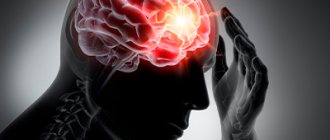Senestopathies (Greek koinos - general, aisthesis - feeling, sensation, pathios - suffering, disease) are pathological sensations, the development of which is not associated with somatic disorders and external influences on sensory organs. The following terms are also used: co-anesthesia, sensations, psychosomatic sensations, somatic hallucinations, somatoform disorder, bodily illusions, dissomesthesia. Described by E. Dupre and P. Camus in 1907. The diagnostic criteria for senestopathy are as follows:
Polymorphism is an extreme variety in which almost all modalities of sensations are represented, as well as numerous submodal sensations. Patients themselves prefer to call them “pains”, although, strictly speaking, senestopathies themselves are very often not pain, this is easily clarified during targeted questioning. Quite often, patients continually change the description of senesthopathy, as if they could not find their exact verbal formula. Often the same patient presents with different senestopathies;
| | Our psychiatric clinic will help you cope with sensoropathy |
Unusual, sometimes very strange, pretentious nature of sensations , which sharply distinguishes them from natural painful sensations caused by somatic pathology. The impression of unusualness is largely due to the fact that the location, projection, configuration and interpretation of senestopathic sensations are very different from what is usually reported by somatic patients. Along with senestopathies, patients may present quite typical complaints of a somatic nature; this circumstance indicates the preservation of the normal process of sensation formation. At the same time, many patients describe ordinary somatic complaints in a rather strange way. The latter circumstance requires caution in assessing the somatic complaints of patients;
The painful affective tone of senestopathic sensations . This is manifested, firstly, by the fact that senestopathies are often a source of extreme suffering for patients, sometimes leading to suicidal thoughts. There are cases when, according to patients, they have never experienced anything more painful in their entire lives. Secondly, various fears are often associated with senestopathies, for example, fear of serious illness, madness, or death. This long-known fact was called “fear in the head” by German authors;
The persistent, seemingly persistent, persistent or even haunting nature of senestopathic sensations . It seems to patients that senestopathies have the ability to forcefully attract their attention. In other words, patients are thereby describing the symptom of painful reflection;
Depressed mood , usually accompanying senestopathies. Depression predominates, combined with anxiety and fears. Depressed mood, meanwhile, is not always recognized by patients. Typical of most of them is a tendency to psychologize their condition. In the minds of such patients, the cause of depressed mood is exclusively senestopathies:
“What kind of mood can you be in when it hurts?” It is often possible to observe that the dynamics of senestopathies are parallel to mood swings. In particular, senestopathies can occur in attacks, accompanied by panic. Such senestopathic attacks are more often regarded as a manifestation of affective pathology, i.e., panic attacks. Cases of mania with senestopathies are very rare;
The uncritical nature of patients , who usually believe that senestopathies, even the most unusual ones, are a sign not of a mental illness, but of some kind of somatic, sometimes serious, disease. Sometimes there are patients with senestopathies and thematically associated delusions of somatic disease;
The area of sensitivity in which senestopathies develop is somesthesia. Painful phenomena in exteroceptive modalities of sensation similar to senestopathies are unknown. In other words, such cross-modal relationships in which the painful qualities of interoreception would be reflected in disturbances of exteroreception apparently do not exist.
There are different approaches to systematizing senestopathies. One of them is anatomical. Thus, A.K. Anufriev (1979) distinguishes the following five types of senestopathies: cardiovascular, central neurological, abdominal, musculoskeletal, and skin-subcutaneous. The author notes that senestopathies localized in the head and heart are especially common.
This approach, and this is where its undoubted advantages lie, is most acceptable in cases of senestopathies with persistent and specific localization. Perhaps it also reflects the point of view according to which senestopathies are somehow related to current or previously occurring somatic pathology. In addition, we cannot exclude the possibility that the localization of senestopathies to a certain extent reflects the patients’ opinion about the significance of the functions of certain organs for him, i.e., it emphasizes the role of psychological factors in the genesis of senestopathies. Some observations have shown, for example, that the localization of senestopathies in the genitals is prognostically unfavorable.
Another approach to systematizing senestopathies is associated with a clinical-psychopathological assessment of the latter. The central idea of this approach is that the severity of the lesion in senestopathies can be established by signs indicating their place in the well-known scale of productive mental disorders, which was presented by A.V. Snezhnevsky in 1983. According to this scale, the severity of a particular symptom is determined by the structure of which syndrome this symptom is included in (it is included and thereby modified in one way or another, and does not simply accompany the main psychopathological syndrome).
Meanwhile, a number of researchers have established that in senestopathies signs of depersonalization, delusions, hallucinations, phenomena of mental automatism and even paraphrenia can be identified (Ushakov, 1973; Ostroglazov, 1975; Eglitis, 1977; Anufriev, 1978; Guteneva, 1979, 1980; Basov, 1980, etc.). Thus, it becomes possible to systematize senestopathies depending on how deep the brain damage that gave rise to them is. This approach forms the basis of this description of senestopathies. The following types of senestopathies will be mentioned: simple, psychosensory, interpretive, hallucinatory and paraphrenic.
Treatment of senestopathy
Diagnostic measures involve collecting a complete and high-quality medical history, as well as complaints and additional studies. It is important to distinguish between senesthopathy and other somatic diseases. If a disease of the internal organs develops, then the distinctive feature will be a feeling of a certain localization and relationship with the position of the organ. Typically, the following types of examinations are carried out:
- MRI
- Ultrasound
- CT.
Symptomatic treatment for senestopathy does not bring the desired results. To stop the disease, analgesics and physiotherapeutic measures are used. Psychologists may be assigned to work to alleviate mental disorders. If the patient suffers from depression or neurosis, antidepressants, antipsychotics and tranquilizers may be prescribed. Psychotherapeutic measures also help reduce the manifestations of the disease.
Treatment of synesthopathy in Samara
At the present stage of development of medicine, an integrated approach to the treatment of senestopathies has been recognized as the most effective, which implies a combination of drug therapy, psychotherapeutic treatment, as well as non-drug treatment methods, such as: intravenous laser irradiation of blood, local ozone therapy and intravenous ozonation of blood, high-tone high-top therapy , magnetotherapeutic complex “Multimag”, transcranial and peripheral magnetic stimulation with the SALUS-TALENT device, carboxytherapy, transcerebral electrotherapy including (electrosleep, central electroanalgesia, mesodiencephalic modulation, micropolarization), manual therapy, local laser therapy (Milta laser).
☎️8(846)302-72-12 Yours, First Neurology.
Symptoms of senestopathy
The symptoms of Senesthopathy are characterized by a large number of different painful sensations that are not localized. When trying to describe feelings, he cannot clearly define where it hurts and in what intensity. Often, experts observe a strong emotional coloring: painful and painful sensations. It is important to note that some patients report emotional distress rather than physical distress. They constantly concentrate on possible painful sensations, unable to be distracted by another subject.
Another difference is the unusual projection. The patient often indicates pain in a place where, according to medical indicators, there should not be pain. Most often, unpleasant sensations manifest themselves in the form of headaches, less often in the chest, heart and limbs. Senesthopathy can occur periodically or on an ongoing basis, sometimes manifesting as attacks.
Forecast
Is there a danger to life with senestopathies? This question can be answered in the negative. In this condition, there is no threat to life or physical damage to the body. These conditions are dangerous only in that a person experiencing constant pain or some unpleasant sensations gradually becomes more irritable. Aggression begins to increase and his behavior changes frequently.
The progression of aggressive behavior in a sick person, especially over a long, debilitating course or with ineffective help, can provoke harm to both oneself and others. Life-threatening behavior is possible, and therefore, in these rare cases, emergency psychiatric care and possibly hospitalization with 24-hour close supervision may be required.
Diseases that provoke the occurrence of senestopathy
Below is a list of the most common diseases in which the symptom of senestopathy may appear.
- Organic lesions of the nervous system of any origin (vascular, atrophic, traumatic, toxic, infectious).
- Consequences of poisoning (including the consequences of alcoholism, drug addiction and substance abuse).
- Schizophrenia and so-called disorders schizophrenia spectrum.
- Affective disorders (bipolar affective disorder, depression, manic states).
- Neurotic disorders.
Depending on the content of the patient’s complaints, various types of disease are distinguished.
Types of senestopathy
It is customary to distinguish several types of senestopathy, which are most often diagnosed in patients.
Senesthopathy syndrome
A painful sensation that can spread to different parts of the body. It can take different forms:
- pressing
- Burning
- Pulling
- Rolling
- contracting
- Boring
- Tearing.
They differ from ordinary pain sensations because they do not have a clear localization. It is important to note that the disease has no clear age boundaries and develops regardless of gender.
Senesthopathy with neurosis
With neurosis, pain occurs quite rarely. Some of the most common symptoms include the following:
- Apparent lesion of a certain area, which is accompanied by cold or burning sensation
- A feeling as if the affected area begins to spin, becomes mobile and has no clear boundaries
- When painful sensations appear, burning and burning pain often appears
- Spread of tense feeling or hardening of certain areas in the body.
As for the descriptions and complaints of patients, they are of an abstract nature, since the person himself is not able to understand what exactly hurts him.
Hallucinations with senestopathy
When senesthopathy and hallucinations occur, the patient cannot understand what is real and what are fictitious events. Among the somatic pathologies identified:
- Lack of differentiation at the sensory level
- Novelty is subjective
- High degree of sensory saturation
- Spatial description of the disease. Characteristics such as unusual, flamboyant, strange, or incongruous often appear in the history.
Accompanied by a change in emotional state, as well as the inability to differentiate this syndrome.
Hypochondriacal senestopathy
This is a whole complex of symptoms, as a result of which the patient develops a belief in something that is not actually happening. A distinctive feature is excessive control of one’s own health, even at a time when it is not necessary.
The development of hypochondriacal senestopathy is evidenced by the following aspects:
- The appearance of heaviness in the abdominal area
- Often loss of appetite and disturbed sleep
- A person constantly strives to discover some non-existent disease in himself.
- The emergence of a feeling of depression.
As diagnostic measures, anamnesis and the patient’s story about his condition are primarily used.
Psychosensory senestopathy
Psychosensorial senestopathy is an imaginary painful sensation with clearly expressed spatial characteristics, i.e., with signs of volume, dimension, direction of movement: “The chest swells, expands, enlarges, stretches... Something comes out from the back of the head. There is pressure on the inside of the head... The head is bursting from the inside, it seems to burst... There is pain in the head, and something is turning over in the temples... It’s as if a knot is being tied in the stomach... The veins are being pulled, twisted... Something is twisting, folding, compressing, gathering into folds inside ... Presses on the forehead from the inside out... It’s like something is spinning and spinning in the head... Presses on the head from the outside towards the center... The pain is oblique, goes from the left and up.” Along with senestopathies, patients often exhibit episodic symptoms of autometamorphopsia: “Pain in the joints, they are twisted in the other direction... The head is compressed, and there is a feeling that it is decreasing in size... It is bursting in the chest, and the chest is rising... Stretching pain in the legs, it’s like the legs stretched out... The skin of the face is pulled, the nose seems to have become sharper.” Violations of the body diagram that are not associated with senestopathies may also be identified. Symptoms of allometamorphopsia are detected much less frequently.
Hermeneutic senestopathies are imaginary painful sensations, accompanied by different interpretations regarding their topic and causes of development. Often these interpretations come to the fore, so that the actual sensations remain in the descriptions of patients, as if in the shadows. The patients' interpretations are very reminiscent of delusional ideas of hypochondriacal content and ideas of dysmorphomania. Depending on the emphasis in this interpretation, the following senestopathies can be identified.
Organotopic senestopathies are pathological sensations that are localized by patients in some organs: “Pain inside the eye sockets... The eardrum vibrates... The vessel in the head itches... Under the skull the vessels pulsate... The vessel under the skin ruptures... By the evening the eyelids begin to hurt... The inner plate of the frontal bone hurts ... Burning in the pericardium and at the apex of the heart... Pain in the three thoracic vertebrae... Pain along the ureter... The apex of the left lung is freezing... Pain at the base of the skull between the hemispheres... Pain in the walls of the stomach... The surface of the cerebral hemispheres tingles and goes numb... The cerebellum burns.”
Associated senestopathies and pathological sensations that patients combine into a semblance of a certain structure: “Pain from the arm goes along the line upward, hits the back of the head, then compresses the heart, and then diverges in the stomach in different directions... Pain from the sternum moves to the tonsils, from there it goes to the heart, and from the heart rises to the head... The pain from the legs stretches up along two lines along the back, moves to the neck, where it ends in two vague points... Numbness of the lower leg turns into a sensation of pain at a point on the thigh, then the inguinal arteries begin to ache, and then the pain becomes subconscious... The central nervous system sends an impulse to the stomach, the stomach contracts, the shocks are sent to the groin, from the groin through a vein they pass to the leg, and then to the big toe of the left foot, from where they return back to the groin. It turns out to be a vicious circle that needs to be broken, and then I will be healthy. To break the connection between the thumb and the central vein through which the finger influences the groin, the thumb must be removed. I have already addressed this request to the surgeon more than once.”
Delusional senestopathies are pathological sensations with imaginary causal connections established by patients: “Blood does not flow into the rectum... Vessels burst... Vessels are thrombosed and the brain does not receive nutrition... The brain lacks oxygen due to lung disease... The veins in the head are inflated, the outflow of blood is disrupted... The blood flow is slowed down, so it’s cold, chilly and the metabolism is disrupted... Dull pain in the heart due to relaxation of the heart muscle... Pain in the cerebral cortex of the inflammatory type.” These patient formulations most likely arise from misunderstood explanations from doctors, reading medical literature, and sometimes they are borrowed from other patients, which the patients subsequently forget about and pass off as their own.
Hallucinatory senestopathies are characterized by the presence of distinct discriminatory elements in the sensations of interoreception, which gives senestopathies some similarity to various deceptions of perception.
Geometric senestopathies are described by patients as having a certain shape, flat or three-dimensional: “Burning on the back in the form of a triangle... Pain in the form of a flat circle... Headaches like a grid - it hurts along the perimeter of the cells, but there is no pain in the middle... Burning in the side like an elongated oval... Pain at a point under the skin of the back of the head... Pain from the point radiates in different directions... Pain from the fingers goes up to the shoulder along two parallel lines... Stripes of cold framed by warmth... Burning in the form of stars... Headache in the form of a triangle convex upward... Pain in the center of the head in the form of a luminous point... The skull hurts along the line under the ears - even chop it off in this place... The pain flashes in zigzags like lightning... A circle the size of a two-kopeck coin freezes... The points under the nails of the index fingers hurt... Ball-shaped pain... The pain rises in bubbles from the bottom up "
Senestopathies with the character of tactile hallucinations: “It’s like there’s a hat on the head... The head hurts, it’s like being squeezed by a fireman’s helmet... The skin burns as if mustard plaster was stuck or a hot iron was applied... It hit the head as if with a stick... The head is freezing, as if a cold wind is blowing it... It seems crumbs stuck to the throat... It feels like someone is pulling your hair... It’s like a cigarette is stuck to your lip... It’s like water is running down on your skin... It’s like droplets of sweat are appearing all over your body... It’s like someone is tickling you.”
Often, imaginary tactile and other external sensations are projected onto the area of interoreception: “There is a tickling in the head, as with a runny nose or allergies... Numbness in the head... Tickling in the chest... Itching, itching in the head... It’s like someone is fingering the intestines with hairy hands... Burning inside the head... In the stomach as if hot blood is pouring... Something is crawling in my head... The pain in the heart is like from a dagger, the end of which sticks out under the shoulder blade, and you just want to pull it out... It’s like a hard lump in the chest... The head is filling with something... Pain from the heart floats up in balls... Pain in the spine, as if it had been pierced by a tube with a diameter of 5–6 mm.” Senestopathies of this type are very reminiscent of visceral hallucinations.
Senestopathies with the character of hallucinations of transformation: “The brain is like a jelly-like mass... The brain seems to be liquid and gurgles... The brain is compressed into a lump... The brain is moving... The brain seems hot and small... The heart seems to be divided into parts... The muscles seem to be stratified... The heart seems to have come off and fallen down... The brain how it separated from the skull and dangles in it.”
Senestopathies with the nature of kinesthetic hallucinations: “The legs seem to be pulled towards the body... The arms, legs, mouth are brought together, the head is thrown back upward... The lips are pulled inwards... The head seems to swing back and forth... It feels like the eyes are starting to squint to the side... There is such tension in the hands, It’s like I’m holding a heavy load.”
Sometimes hallucinatory senestopathies are complemented by acoustic, gustatory, olfactory or visual elementary hallucinations of the imagination: “The brain is clearly separated from the membranes - you can hear them coming apart... There’s something squelching in my head, I hear it... Pain stretches along the threads and you can hear them rattling... Something sickly sweet is spinning in my head... Everything inside is burning, burning, I feel like it smells burnt... It hit my head, the pain flew from left to right and sparkled, like during a thunderstorm.” At the same time, most patients exhibit fragmentary deceptions of perception that are not associated with senestopathies.
Treatment of senestopathy (psychiatry)
First of all, a specialist must differentiate the patient’s condition and exclude possible physiological diseases of the internal organs. In addition to physical examination, psychotherapists and psychologists work with the patient to make a diagnosis.
If the disease is accompanied by psychosis, then antipsychotics can be used in treatment. With the development of neurosis - antidepressants and tranquilizers.
When senestopathy becomes chronic, this means that qualitative changes have occurred in the brain, which may be irreversible. If such a pathology occurs, then psychotropic drugs will no longer be able to cope with the disease. As an additional therapy, many specialists use hypnosis to find out the causes of the syndrome and reduce the manifestation of side symptoms.
The treatment plan is created exclusively on an individual basis after all examinations have been completed. Therefore, there is no clear picture of treatment in general terms and specialists primarily rely on the collected anamnesis.
What causes phantom pain or senestopathy?
The disease senestopathy is a consequence of the following:
— Severe psychological trauma; — Panic attacks about the risk of serious illnesses; — Development of neurological abnormalities.
But only a specialized psychiatrist who has already dealt with similar diseases in his medical practice can thoroughly determine the cause. Most often, senestopathy in psychiatry is included in a complex of deviations, in the syndrome of mental automatism. This means that the treatment of senestopathy should be comprehensive and versatile with constant monitoring of the patient’s condition. This diagnosis can be given to people with manifestations of paranoia, brain cancer, schizophrenia , neurasthenia, and so on.








